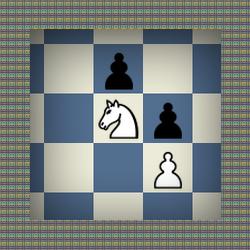
The Sicilian Hole
Many openings (especially when you play Black) have specific strategical problems typical for that particular opening. If you play the French Defense, then the bishop on c8 is your constant headache. In the Tarrasch Defense you need to live with an isolated queen pawn. The Dutch Stonewall gives White full control over the 'e5' square.
The typical problem for many variations of the Sicilian Defense, especially those where Black plays e7-e5 (the Sveshnikov variation, the Boleslavsky variation, et cetera ) is a permanent 'hole' on the 'd5' square. Black hopes that the activity of his pieces should compensate for this weakness, but if something goes wrong...
The next game illustrates such a case very well. In fact, it is one of those games which each proverbial Russian schoolboy should know. The reason is simple: it was published in the famous Soviet book that was preparing kids to reach the Soviet 3rd category (roughly USCF 1500 level).
The diagrammed position is picture perfect of the strategical disaster of Black's plan. Notice the smart 15.Bg5! move that eliminated the only defender of the 'd5' square - Nf6. As the result, Black's 'bad' Bf6 was not a match to the beautiful Nd5.
The following game demonstrates a slightly more complicated case of the same positional concept. White first sacrificed a pawn to trade Black's Be6 - the main defender of the key 'd5' square. And the maneuvre Bg5xf6 should be already familiar to you by the previous game.
Again Black's dark-squared bishop was amazingly useless.
While these two above mentioned games are really 'positional chess 101' (practically all Soviet chess players of my generation learned them in a very early age), this pattern is so common that you can easily find hundreds of good examples. Look how Bobby Fischer implements the same strategical tools to obtain a strategically winning position with his Nd5 totally dominating the whole board. Just like Smyslov and Boleslavsky, he trades the light squared bishops first and then swaps his dark-squared bishop for his opponent's knight. You can see why Spassky once called Fischer the best product of the Soviet Chess School!

Finally, let me show you one of the most amazing games with this strategical idea. No matter how many times you replay it, the game will always fascinate you. In order to eliminate the defender of the key 'd5' square, Garry Kasparov sacrifices the whole exchange!
A truly unbelievable game! Kasparov sacrificed the exchange in the opening and then played like if nothing happened!

As you could see in all these games, Black's dark-squared bishop cannot really compete with White's Nd5. But what happens if instead of the knight White has a bishop on the 'd5' square? We will discuss this situation next week!
RELATED STUDY MATERIAL
- Read WGM Natalija Pogonina's article Dark and Light Square Weaknesses;
- Check out IM David Pruess's Chess Mentor Weak Color Complexes Explained;
- Watch GM Melikset Khachiyan's video 2012 American Open: Light Square Domination.



